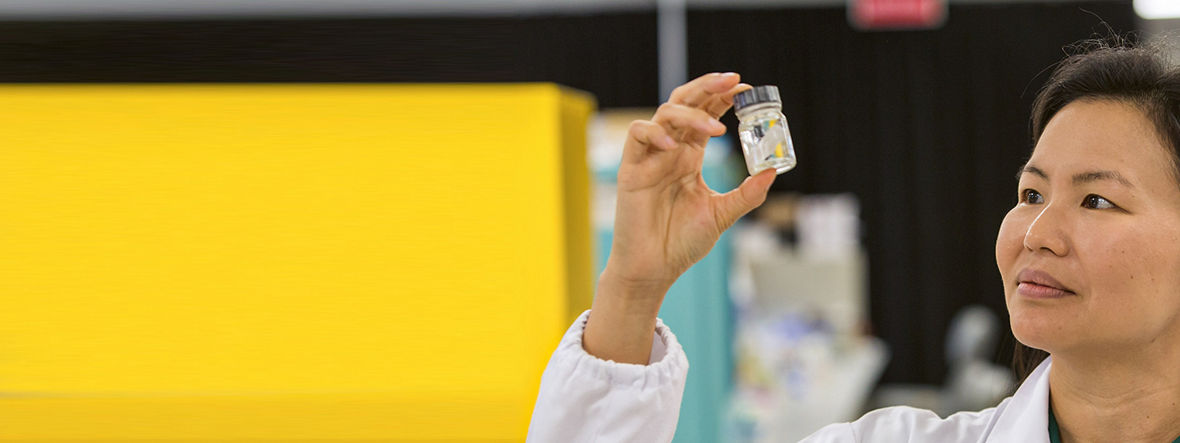Professor Yeong, in your research you have been interested in every possible kind of 3D printing. Why are you so fascinated by bioprinting in particular?
I want to develop bioprinted constructs that can ultimately replace organ transplants from donors. In this way we can improve patients’ quality of life. Bioprinting is the technology that will make tissue engineering possible in the first place. But even before we can do that, we can use this technology to produce in vitro models that reduce animal testing and improve the predictability of therapeutics testing.
How does this technology work?
Bioprinting is 3D printing that uses cells and scaffolding biomaterials as inks. The biomaterials are used to construct the scaffolding. By using a bioprinter, we can precisely position the deposition of cells and biomaterials. This gives us the ability to design the optimal 3D environment for cell growth, develop new strategies for cultivating different kinds of cells and materials together, and manipulate the shape of cellular constructs.
»One of the major challenges to overcome is the supply of nutrients.«
Wai Yee Yeong
Which organs can theoretically be printed using bioprinters?
Recently I have concentrated my research on skin, retina, and lungs. I have also been working together with hospitals to develop new solutions. For example, I looked at how the pancreas can help us gain a better understanding of diabetes. All of the projects that I am currently working on require different design methods and different formulations of materials.
Lungs from a printer – that sounds like a dream of the future. How far has this technology been developed to date?
We are at a very exciting stage right now. Currently we can already print two-dimensional tissues such as skin, as well as thin tubular structures that are used for the in vitro testing of drugs and toxic compounds.
What are the biggest obstacles that hinder the development of more complex applications such as tissue and organ transplants?
One of the major challenges to overcome is the supply of nutrients. That’s why we are looking into the cultivation of vascular tissue. On account of the resolution of current bioprinters, we’re starting with small blood vessels. Another obstacle that has hindered the development of organ printing so far is the limited number of materials that can currently be used as inks. For bioprinting we require soft gel-like materials that promote the growth and migration of cells. However, these materials do not have the mechanical integrity to retain the shape we desire, so we need to develop strategies for enhancing their mechanical integrity. We also need biomaterial inks or additives that promote the interactions between the host tissue and the graft tissue, so that the printed organ will be successfully integrated with the patient’s tissue following the implantation.

»Es ist heute schon möglich, zweidimensionales Gewebe wie Haut zu drucken.«
How are you working together with Evonik in this area?
Among other things, we are co-mentoring a Ph.D. student who is focusing on the area of bioink. In order to enable the printing of larger biological constructs, we need a greater selection of inks that have varying material characteristics. For extrusion-based bio-printing techniques, smart materials that respond to specific stimuli are of interest.
When will you start to produce the first organs?
That process still has a long way to go. We need to use a lot of cells, and this requirement increases with the size of the tissue construct and the scale-up of the application. This obstacle is compounded by the challenges and concerns related to the use of primary cells that are isolated directly from patients. To address this problem, we are currently investigating the use of induced pluripotent (adult) stem cells. We are still at an early stage of integrating stem cells and bioprinting in order to expand the overlapping applications of these two areas. Another challenge is the nutrient solutions that are needed. We require “universal” cell culture media to support the printed constructs that consist of multiple cell types. Currently most cell culture media have been optimized for only one or two types of cells.

Do you see these obstacles being overcome in five to ten years’ time?
I think it is possible for skin, because its structure is less complex. This applies in particular to tissue models, particularly tissue constructs that do not require a lot of support from blood vessels, such as cornea and retinal layers. Large-diameter blood vessel grafts will probably become available as well. For organs with a complex structure and a high level of functionality, such as the liver and neural tissue, we will need to incorporate significantly more biological inputs.
In your opinion, what possibilities are opening up for 3D printing in general in the field of medicine?
Right now, the best results we can achieve are implanted medical devices that are produced on a 3D printer. However, these implants are not true replicates of the original tissue. I believe that bioprinting will provide us with the tools, platforms, and financial resources that we need in order to cultivate a truly biological construct that can be substituted for the original organ. We also want to create bionic organs that combine living and non-living materials. Such constructs might function even better than a fully biological construct.
Why is so much know-how in the area of bioprinting technology concentrated in Singapore?
I believe that we occupy a strong leadership position in the field of 3D printing in Asia and globally. At the research level, we have strong support from the government—for example, we have one of the best-equipped university research labs in the region. This strong foundation is very closely integrated into the overall research landscape in Singapore, particularly in the area of biosciences. In addition to our research partnerships with universities and research institutes, we also work with technology companies such as Evonik and HP Inc. to look for solutions that address real industry needs.


